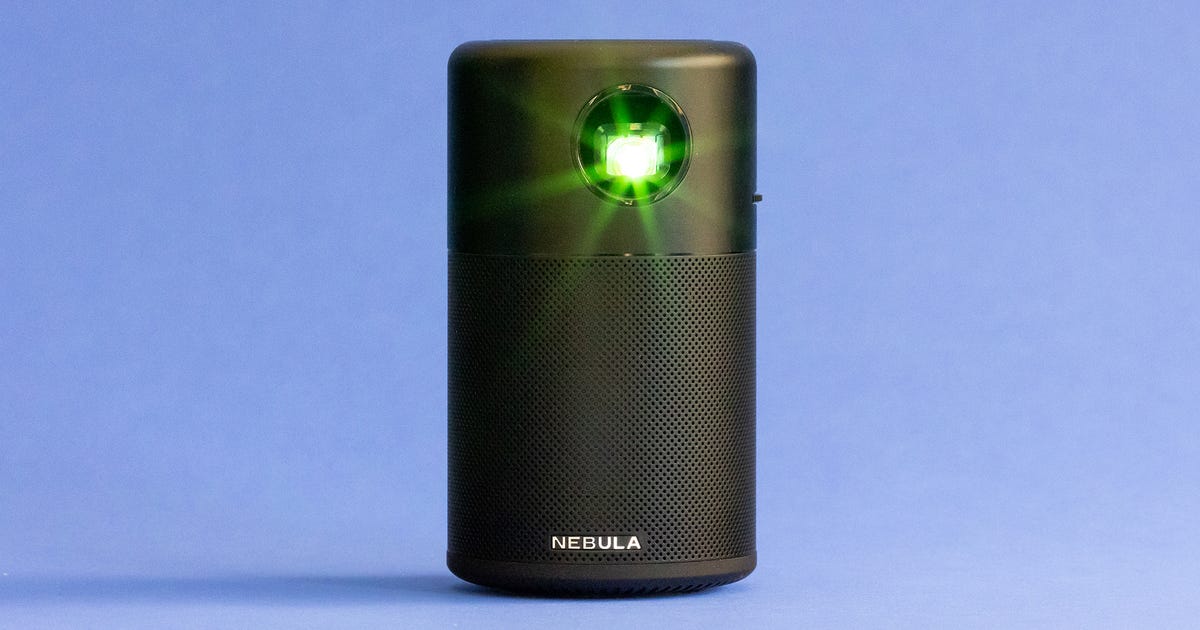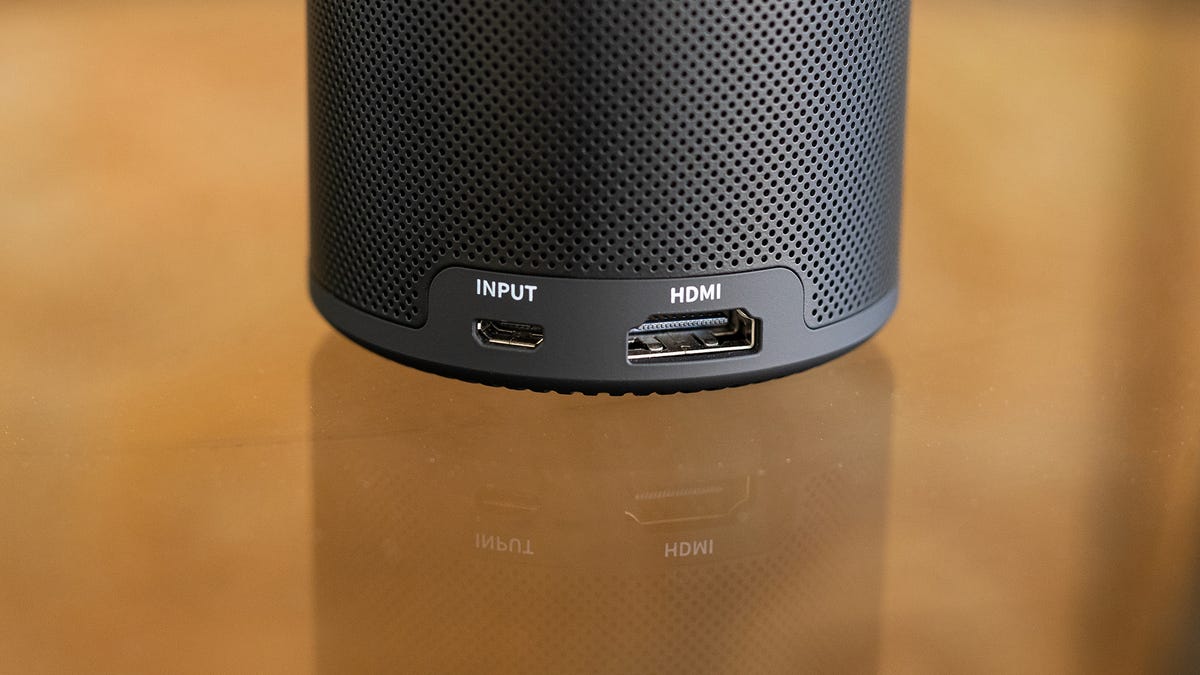Anker nebula capsule pico projector review phosphorescent definition anker nebula capsule pico projector review phosphorescent plankton anker nebula capsule ii can i use my firestick with anker nebula capsule anker nebula capsule buy today anker nebula capsule pro anker nebula cosmos laser 4k projector anker nebula apollo anker nebula solar portable anker nebula soundbar anker nebula projector review

Anker Nebula Capsule Pico Projector Review: Phosphorescent Pocket Pal
Let's say you and the fam are going camping. Maybe it's a national park, maybe it's your backyard. Watching a movie under the stars is the perfect end to a summer day, and the Anker Nebula Capsule is miniature ticket to outdoor theater bliss. Smaller than any of the portable projectors we've reviewed recently, it's the size of a can of soda yet can project an image just about anywhere.
That adorable size comes at a cost. Not a literal cost, mind you -- the Capsule's price is as small as its size. The cost I'm referring to is picture quality. The image it projects is standard definition, so it's got big, chunky pixels. It's also quite dim, rated at only 100 lumens, and in my tests it put out even less.
As long as you're not expecting to see a 100-inch image with the sun still up, the Capsule is good at what it does for the price. After all, there aren't many projectors that let you stream and project Netflix from something that fits in your pocket.
Tiny size, tiny specs
- Native resolution: 854x480 pixels (480p)
- HDR-compatible: No
- 4K-compatible: No
- 3D-compatible: No
- Lumens spec: 100
- Zoom: None
- Lens shift: None
- Lamp life (Normal mode): 30,000 hours
The Capsule has standard-definition resolution and is the dimmest projector we've measured in years. Anker claims 100 lumens and I measured 85. For comparison, the AAXA P6X is only a little more expensive, has 1,280x800 resolution and measured 487 lumens, roughly 5 times brighter. But brightness isn't everything, as I discuss in the comparison below.
The Capsule's battery has 5,200-mAh storage capacity -- far smaller than the AAXA's 15,000 mAh, but with a weaker light source it doesn't need a massive battery. Anker claims 4-hour playtime with video and 30 with just audio, which is pretty close to the AAXA. And because it charges via USB, you can connect a power bank and extend the playtime even longer.
Focus is achieved via a small dial, which I prefer to the the "automatic" method found on many other portable projectors because it lets me get an image in focus faster. There's a tripod mount on the bottom, which is a nice addition.
Connections (well... connection)

A full-sized HDMI input is both unexpected and welcome.
Geoff Morrison/CNET- HDMI inputs: 1
- USB port: 1 (micro, for power)
- Audio input and output: Bluetooth
- Digital audio output: None
- Internet: 802.11a/b/g/n
- Remote: Not backlit, also app (iOS/Android)
The full-sized HDMI input is unexpected in a projector of this size. Even the significantly larger Samsung Freestyle makes due with a mini HDMI connector. You can use the Capsule as a Bluetooth speaker. It's a small speaker in a small cabinet, but sounds fine. At maximum volume it's a bit shouty, but again for the size and price it's acceptable.
The remote is taller than the projector itself. The black-on-black buttons aren't ideal to navigate in the dark, but for the price a backlit remote is probably too big an ask. You're probably not going to use it much anyway. The free Nebula Connect app is easier to use, with a large "trackpad" area for menu navigation, and it has a keyboard that allows you to easily input streaming service logins.
Unlike many portable projectors, the Capsule has Netflix right on the homepage, which is great, but I was annoyed I couldn't use the physical remote -- just the mobile app -- to navigate. Amazon, YouTube, Vudu and a variety of other apps are available on the Capsule too, but there's no HBO Max. You can't cast copyrighted video content from your phone, but you can select the Capsule as a speaker with Spotify
Picture quality comparisons

The photographer clearly has an... eclectic taste in beverages.
Geoff Morrison/CNETThe AAXA P6X is the closest in price to the Capsule of the projectors we've reviewed and liked. The Anker Nebula Mars II Pro is a lot more expensive, but it's our favorite portable projector overall. It's brighter than the Capsule but a lot bigger, although "bigger" is definitely relative here. I viewed them side-by-side on a 102-inch 1.0-gain screen.
Since the Capsule and AAXA are closest in price I compared them first. Unsurprisingly, the AAXA is blindingly bright compared to the Capsule but the image overall looks terrible. The AAXA is brightness over all else. And that's fine, but it's just one aspect of the projector's performance.
Though far dimmer, the Capsule absolutely has a better image. Far more natural looking, more like a full-sized projector, just scaled down in brightness and resolution. That's not to say it looks amazing, but it looks more realistic and natural than the AAXA for sure. It'd look even better if it had any picture settings beyond color temperature. Some tweaks to the brightness, contrast, and color would likely improve it a bit more.

The remote is fine, but you're better off leaving it at home and using the app instead.
Geoff Morrison/CNETReally, it's a question of image size. The AAXA can create a somewhat dim 100-inch image. The Capsule really can't at all, but it can produce a better-looking (though still fairly dim) 50-inch image. So as long as you're not expecting it to fill the entire side of your garage, the Capsule's size, image quality, and built-in streaming make it a far closer comparison than the brightness specs would imply.
The Capsule's niche is its incredible portability, letting you project a midsize TV image, or ideally smaller, on the go. Because of how well it does being small, a lot of the performance aspects are less of an issue than they would be if it was much larger.
What does spending nearly twice as much get you? The Mars II looks significantly better, better detail, brighter, less faded, and so on. It plays louder too. However, it's a lunchbox to the Capsule's soda can. So again, if extreme portability is what's most important to you, the Capsule is a superior choice. If a bit more bulk is OK, go with the Mars II Pro if you can afford it.
Compact capsule

In person the Capsule looks even smaller than it does in photos.
Geoff Morrison/CNETOne of the most important things to keep in mind with small portable projectors is to manage your expectations. Every company's marketing shows groups of people, often outside, enjoying huge bright images, but that's not the reality. Compared to a decent-sized TVs or home theater projector, the Capsule's image is dim, soft and small.
There's an old quote, misattributed to Einstein, about judging a fish on its ability to climb a tree. The Capsule's appeal should be judged by its diminutive size, not its picture. The folks at Anker have done a good job with the other aspects, but you can get better performance elsewhere, like the ultrabright AAXA or Anker's own Mars II Pro. Both are also larger and more expensive than the Capsule.
The best things about the Capsule are the way it fits inconspicuously in a backpack and lets you stream a movie on the side of a tent under the stars. Maybe you hiked to get to that tent, or maybe you're on your porch. Both can be good times.
Source
Blog Archive
-
▼
2022
(148)
-
▼
December
(35)
- Hackers Threaten To Release Symantec Source Code T...
- 9 Great Reads From CNET This Week: Tech Fails, NFT...
- What Is Shrinkflation And What Does It Mean For Yo...
- 3 Spotify Audio Settings That All 188 Million Subs...
- Huawei Nova Review: Huawei Hopes Nova And Nova Plu...
- FEMA Grants, SBA Loans: How To Get Government Help...
- Don't Pull A Rudy Giuliani: Prevent Butt-dialing W...
- Peloton Guide Review: Turn Any TV Into A Guided St...
- Facebook To Meta: A New Name But The Same Old Prob...
- LG Gram 16 2-in-1 (2022) Review: Light, Long Batte...
- Best MacBook For 2022
- 'Thor: Love And Thunder' New Trailer Exposes Chris...
- See A Great White Shark Nibble A Cape Cod Research...
- Nvidia GeForce Now Replaces Founders Subscription ...
- IPhone Won't Get Under-Display Face ID, Camera Unt...
- 2021 Kia Seltos Debuts At LA Auto Show, On Sale Q1...
- Infant Formula Inquiry Launched By FTC
- Keep Your Home Spotless With The Hoover CleanSlate...
- 3 Upgrades Apple Gave The IPhone SE In 2022
- Instagram Promotes Pro-Eating Disorder Content To ...
- 2023 GMC Canyon Is A Mean Off-Road Machine
- 2023 Honda CR-V Hybrid Has Sharper Looks, More Ref...
- The Best Sci-Fi TV Shows On HBO Max
- Would You Spend $10K On NFT Stick Figures? Lots Of...
- Need Better Cell Phone Reception? Try These 10 Tip...
- Sci-fi Screenwriter Gary Whitta Wants Kids To Poop...
- Sonos' Next Speaker Could Be Its 'Best-Sounding' Y...
- Netflix Launches First Mobile Games For Android Gl...
- Samsung's Next Metaverse Move Is A Roblox Game
- Amazon Delivery Drivers Risk Write-ups And Injurie...
- Yes, You Can Use Windows Software On A Chromebook
- Huawei Exceeds 200 Million Smartphone Shipments, S...
- NHTSA Has Phantom Braking Questions For Tesla, Ask...
- The Simpsons At 30: One Big Mistake Cost The Show ...
- Anker Nebula Capsule Pico Projector Review: Phosph...
-
▼
December
(35)
Total Pageviews
Search This Blog
Popular Posts
-
Elden ring player guide elden ring new player tips playing elden ring early elden ring the elden ring elden ring story guide elden ring full...
-
Whole house clean with me clean up your house how to clean your whole house how to clean the whole house cleaning the whole house help me cl...
-
Oppo find x3 pro 5 reasons i love oppo find x3 pro 5 reasons i love oppo find x3 pro 5 reasons we stand oppo find x3 pro 5g ราคา oppo find x...
